Intel SSD DC P3700 Review: The PCIe SSD Transition Begins with NVMe
by Anand Lal Shimpi on June 3, 2014 2:00 AM EST- Posted in
- Storage
- SSDs
- Intel
- Intel SSD DC P3700
- NVMe
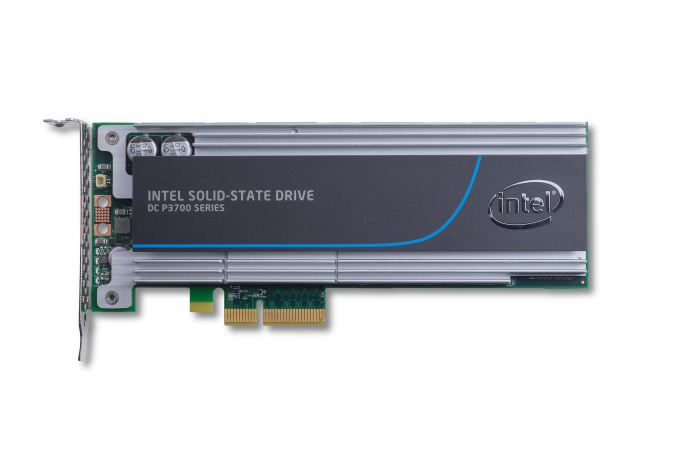
In 2008 Intel introduced its first SSD, the X25-M, and with it Intel ushered in a new era of primary storage based on non-volatile memory. Intel may have been there at the beginning, but it missed out on most of the evolution that followed. It wasn't until late 2012, four years later, that Intel showed up with another major controller innovation. The Intel SSD DC S3700 added a focus on IO consistency, which had a remarkable impact on both enterprise and consumer workloads. Once again Intel found itself at the forefront of innovation in the SSD space, only to let others catch up in the coming years. Now, roughly two years later, Intel is back again with another significant evolution of its solid state storage architecture.
Nearly all prior Intel drives, as well as drives of its most qualified competitors have played within the confines of the SATA interface. Designed for and limited by the hard drives that came before it, SSDs used SATA to sneak in and take over the high performance market, but they did so out of necessity, not preference. The SATA interface and the hard drive form factors that went along with it were the sheep's clothing to the SSD's wolf. It became clear early on that a higher bandwidth interface was necessary to really give SSDs room to grow.
We saw a quick transition from 3Gbps to 6Gbps SATA for SSDs, but rather than move to 12Gbps SATA only to saturate it a year later most SSD makers set their eyes on PCIe. With PCIe 3.0 x16 already capable of delivering 128Gbps of bandwidth, it's clear this was the appropriate IO interface for SSDs. Many SSD vendors saw the writing on the wall initially, but their PCIe based SSD solutions typically leveraged a bunch of SATA SSD controllers behind a PCIe RAID controller. Only a select few PCIe SSD makers developed their own native controllers. Micron was among the first to really push a native PCIe solution with its P320h and P420m drives.
Bandwidth limitations were only one reason to want to ditch SATA. The other bit of legacy that needed shedding was AHCI, the interface protocol for communication between host machines and their SATA HBAs (Host Bus Adaptors). AHCI was designed for a world where low latency NAND based SSDs didn't exist. It ends up being a fine protocol for communicating with high latency mechanical disks, but one that consumes an inordinate amount of CPU cycles for high performance SSDs.
In the example above, the Linux AHCI stack alone requires around 27,000 cycles. The result is you need 10 Sandy Bridge CPU cores to drive 1 million IOPS. The solution is a new lightweight, low latency interface - one designed around SSDs and not hard drives. The result is NVMe (Non-Volatile Memory Express otherwise known as NVM Host Controller Interface Specification - NVMHCI). And in the same example, total NVMe overhead is reduced to 10,000 cycles, or roughly 3.5 Sandy Bridge cores needed to drive 1 million IOPS.
NVMe drives do require updated OS/driver support. Windows 8.1 and Server 2012R2 both include NVMe support out of the box, older OSes require the use of a miniport driver to enable NVMe support. Booting to NVMe drives shouldn't be an issue either.
NVMe is a standard that seems to have industry support behind it. Samsung already launched its own NVMe drives, SandForce announced NVMe support with its SF3700 and today Intel is announcing a family of NVMe SSDs.
The Intel SSD DC P3700, P3600 and P3500 are all PCIe SSDs that feature a custom Intel NVMe controller. The controller is an evolution of the design used in the S3700/S3500, with improved internal bandwidth via an expanded 18-channel design, reduced internal latencies and NVMe support built in. The controller connects to as much as 2TB of Intel's own 20nm MLC NAND. The three different drives offer varying endurance and performance needs:
The pricing is insanely competitive for brand new technology. The highest endurance P3700 drive is priced at around $3/GB, which is similar to what enthusiasts were paying for their SSDs not too long ago. The P3600 trades some performance and endurance for $1.95/GB, and the P3500 drops pricing down to $1.495/GB. The P3700 ships with Intel's highest endurance NAND and highest over provisioning percentage (25% spare area vs. 12% on the P3600 and 7% on the P3500). DRAM capacities range from 512MB to 2.5GB of DDR3L on-board. All drives will be available in half-height, half-length PCIe 3.0 x4 add in cards or 2.5" SFF-8639 drives.
Intel sent us a 1.6TB DC P3700 for review. Based on Intel's 400GB drive pricing from the table above, the drive we're reviewing should retail for $4828.
IO Consistency
A cornerstone of Intel's DC S3700 architecture was its IO consistency. As the P3700 leverages the same basic controller architecture as the S3700, I'd expect a similar IO consistency story. I ran a slightly modified version of our IO consistency test, but the results should still give us some insight into the P3700's behavior from a consistency standpoint:
IO consistency seems pretty solid, the IOs are definitely not as tightly grouped as we've seen elsewhere. The P3700 still appears to be reasonably consistent and it does attempt to increase performance over time.


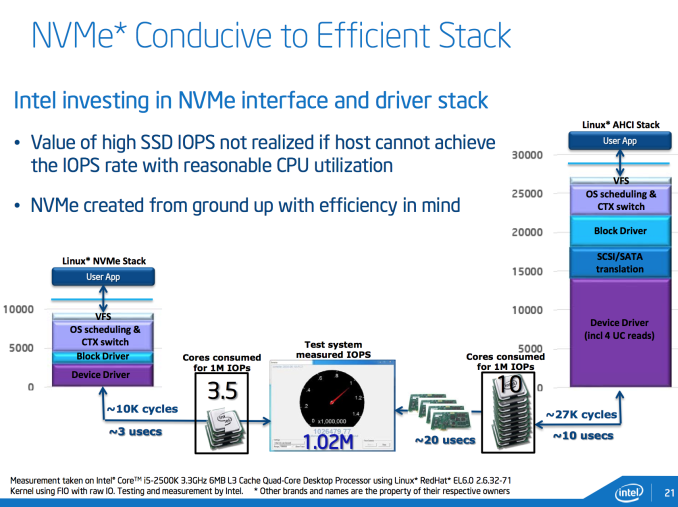
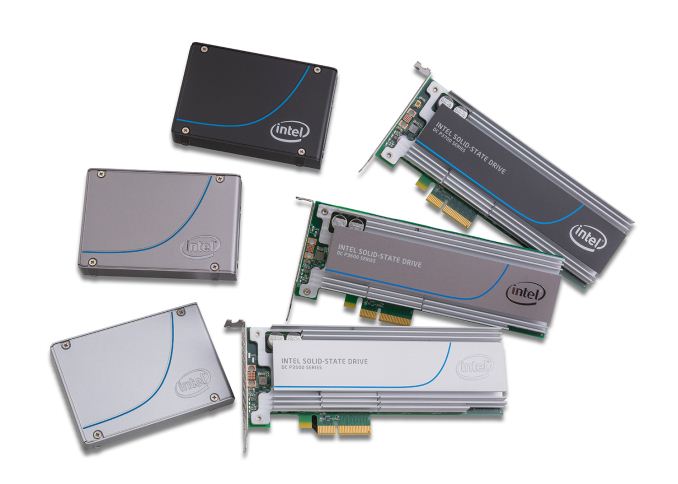
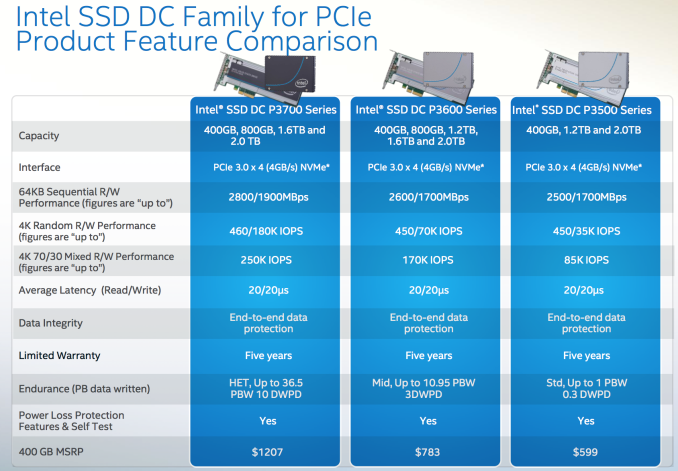






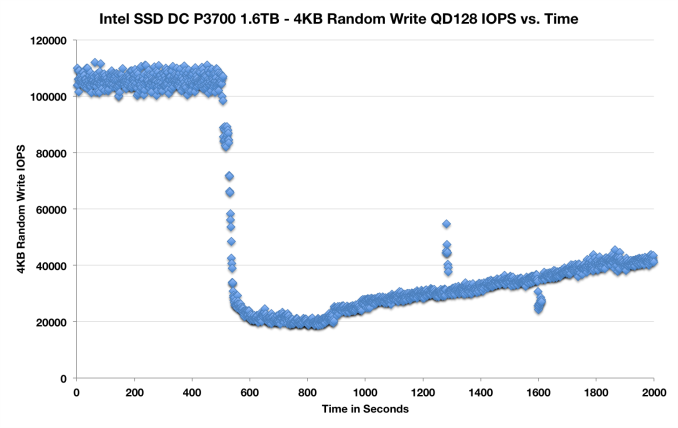








85 Comments
View All Comments
gospadin - Tuesday, June 3, 2014 - link
tRead on MLC NAND is > 50us. 10us latency will never be achievable with an MLC NAND back-end without a redesign of the NAND array.mavere - Friday, June 6, 2014 - link
"I am angry because my ridiculous fantasies aren't fulfilled."Antronman - Tuesday, June 3, 2014 - link
Fusion iO blows it all away.TelstarTOS - Tuesday, June 3, 2014 - link
did they make it bootable on windows after what 8 years?extide - Tuesday, June 3, 2014 - link
At what cost?I'd definitely like to see some FusionIO benches on this site...
TelstarTOS - Tuesday, June 3, 2014 - link
At last Intel showed its muscles again.If in a 6 month timeframe something similar and cheaper doesnt come out, the 400GB P3600 will be my next SSD. Looking forward SF3700 really curiously now.
Kevin G - Tuesday, June 3, 2014 - link
I love the raw speed that this delivers. It does not hold anything back in terms of performance. I'm genuinely excited as to what a full blown server implementation using 16x PCIe 3.0 could provide.My only issue is one of capacity and cost per GB of storage. It is good to see 2 TB solutions but honestly I was hoping for a bit more. Moving away from the 2.5" SATA, M.2 and mSATA formats should enable far more NAND packages. I can see Intel limiting these consumer/prosumer cards to lower capacities to keep the higher capacity units in the enterprise space where ultra fast storage carries a higher premium. Speaking of costs, I was prepared to accept this as costing a bit more but not this much. Things like moving to an 18 channel design and the cost of the NVMe controller would be more expensive but not quiet this much. I was hoping to see something closer to $1/GB as the 2.5" SATA market is well below that and starting to approach $0.50/GB. Speed can carry a premium but those lower $/GB SATA drives are still pretty fast on their own.
Actually are there any subjective impressions? Does the P3700 feel noticeably faster in day-to-day usage than a generic 2.5" SATA SDD?
I'd also like to see some boot testing. Generally there are some quirks here and there that crop up with technology introductions.
kaix2 - Tuesday, June 3, 2014 - link
with the p3700 drive rated at 10dw/d it's aimed at high end enterprise. expecting $1/GB for this high end of a drive isn't realistic. also it's not a fair comparison if you simply compare the price of this drive to an average consumer sata drive and not take nand endurance and quality into account.Sacco_svd - Tuesday, June 3, 2014 - link
P3700 / 2048gb*3dollar = 6144 dollarsP3500 / 2048gb*1.469dollar = 3061.76 dollars
If those are going to be the prices they're still not competitively cheap, by a big margin.
balindad - Tuesday, June 3, 2014 - link
As mentioned else where, could you drop this in on any open pcie and have it work and bootable with no other upgrades needed as long as you're running windows 8?